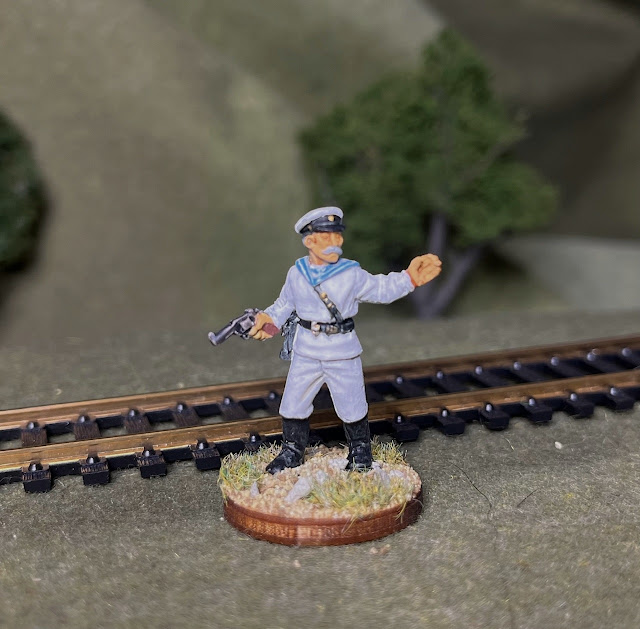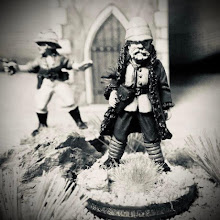So why do the smallest contingent of the 8 Nations Alliance? I blame the von Trapp Family Singers.As regular readers of my blog know, while recovering from foot surgery (hmmm . . . how long was I in the infantry?) I watched the movie The von Trapp Family: A Life of Music based on Agathe von Trapp's memoir (the oldest daughter), Memories Before and After The Sound of Music. Researching Captain von Trapp's military career I discovered: HOLY COW!!! HE WAS DECORATED FOR BRAVERY AS A NAVAL CADET DURING THE BOXER REBELLION! Thus a project was born.
The complete, 12 figure unit to use with The Men Who Would be Kings.
The figures are from Copplestone Castings Back of Beyond range and are Russian Naval Command and Russian Navy Sailors. During this time, depending on the area and the region of service, many naval uniforms were similar and at the 28 mm scale the differences are so minor that it does not even matter. For example, you can use British Naval Brigade with Sennet hats for French Navy during the Seymour Expedition as that is what the French sailors wore. For the Legation defense, specifically the Peitang Cathedral, the French Sailors had the hat (I'll have to look up what it is really called) with the pom-pom on top.
Seekadet Georg Johannes von Trapp (accidentally painted as a Korvettenleutnant - the stripe around the cuffs should end at the loop for Seekadet), Matrose (Seaman) Antoine Antumac and Waffenmatrose Ernest Grbac.
Anyway . . . another reason I did the Austro-Hungarian Naval contingent was because of variety - you have to love having white figures in your force. My initial Field Force for the 8 Nation Alliance will be a generic for with units that will add variety and color to the tabletop.
Quartermaster Carl Raschka.
Seventy-five members of the crew of the SMS Zenta were attached to the Peking Relief Expedition. Later they would be joined by 160 sailors from two other Austro-Hungarian ships. In addition, before hostilities commenced, the captain of the Zenta, Fregattenkapitän (Commander) Eduard Thomann von Montalmar, one officer, 2 cadets and 30 sailors went to help reinforce the Legation Quarter. As the senior allied officer von Montalmar was placed in command. Now we have controversy - either through bad intelligence, a lack of good judgement or cowardice, depending on the source, von Montalmar had all forces fall back on the British Legation which allowed many Legation buildings to be burned and parts of the Legation Quarter to be seized. A counterattack restored the perimeter. He was relived of command. On July 8, 1900, he was mortally wounded by a grenade; some accounts state he recklessly exposed himself in combat to make up for the blow to his honor.
Matrose Joseph Basurina, the photo bomb known as Waffenmatrose Grbac and Matrose Nicolas Hranuelli.
The most famous action of the sailors was the storming of the Taku forts by naval personnel of the Zenta and German marines.
"The Capture of the Forts at Taku", by Fritz Neumann in the Anne S.K. Brown Military Collection, Brown University.
The figures were a blast to paint - nicely sculpted figures make the painting easy! Copplestone is one of my favorites and the figures were a joy to paint. Uniforms that are primarily white can always be a challenge. I primed them with Citadel Wraithbone Grey and then did the highlights of the white uniforms with Vallejo Flat White once or twice. Not bad for a quick and easy paintjob and it follows The Colonel's rule Number 1 of painting: Paint for gaming distance (unless you just have to paint a masterpiece of a special figure).
Matrose's Mathieu Simcic, Joseph Bozikoo and Yure Petrovac.
The valiant crew of the SMS Zenta.











Having put Boxer Rebellion forces together a few years ago- I am enjoying watching your progress!
ReplyDeleteThanks John. It’s going to be a lot of fun.
Delete